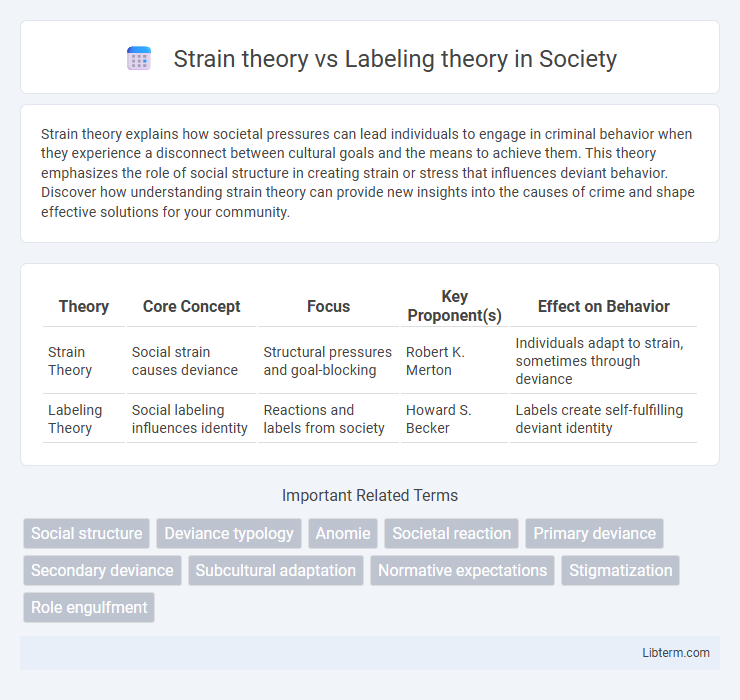Strain theory explains how societal pressures can lead individuals to engage in criminal behavior when they experience a disconnect between cultural goals and the means to achieve them. This theory emphasizes the role of social structure in creating strain or stress that influences deviant behavior. Discover how understanding strain theory can provide new insights into the causes of crime and shape effective solutions for your community.
Table of Comparison
| Theory | Core Concept | Focus | Key Proponent(s) | Effect on Behavior |
|---|---|---|---|---|
| Strain Theory | Social strain causes deviance | Structural pressures and goal-blocking | Robert K. Merton | Individuals adapt to strain, sometimes through deviance |
| Labeling Theory | Social labeling influences identity | Reactions and labels from society | Howard S. Becker | Labels create self-fulfilling deviant identity |
Introduction to Criminological Theories
Strain theory explains criminal behavior as a result of the pressure individuals experience when they cannot achieve culturally approved goals through legitimate means, highlighting the role of social structures in fostering deviance. Labeling theory emphasizes the impact of societal reaction and the stigmatization process, where individuals become deviant due to being labeled as such by authorities or the community. Both theories offer critical perspectives within criminological theory by addressing how social forces and identity shape criminal behavior and recidivism.
Overview of Strain Theory
Strain theory explains deviant behavior as a response to the pressure individuals experience when they cannot achieve culturally approved goals through legitimate means. It emphasizes structural inequalities that create a disconnect between societal expectations and accessible opportunities. This theory highlights how frustration from blocked goals can lead to innovation, rebellion, or other forms of deviance.
Key Concepts of Strain Theory
Strain theory emphasizes the pressure individuals feel when societal goals and the means to achieve them are misaligned, leading to deviant behavior as a coping mechanism. Key concepts include cultural goals, institutionalized means, and the resulting strain or frustration experienced when access to these means is blocked. This theory highlights how social structures generate strain that influences individuals to engage in crime or deviance to achieve culturally approved goals.
Overview of Labeling Theory
Labeling theory emphasizes how societal reaction and labels assigned to individuals influence their self-identity and behavior, often leading to a self-fulfilling prophecy of deviance. It argues that deviance is not inherent in an act but is a consequence of the labels imposed by society, which can marginalize individuals and perpetuate criminal behavior. This theory contrasts with strain theory, which focuses on structural pressures and social inequalities as the root causes of deviance.
Key Concepts of Labeling Theory
Labeling theory centers on the idea that deviance is not inherent in an act but results from societal reactions and labels assigned to individuals, which can lead to a self-fulfilling prophecy where labeled individuals adopt deviant identities. Key concepts include primary deviance, where initial rule-breaking occurs without a deviant identity, and secondary deviance, which develops after acceptance of the deviant label. The process of stigmatization and the power dynamics involved in the labeling process significantly influence an individual's social identity and subsequent behavior.
Major Differences between Strain and Labeling Theories
Strain theory emphasizes societal pressures and structural barriers that push individuals toward deviant behavior, highlighting the role of economic inequality and blocked opportunities in causing crime. Labeling theory focuses on the social process of labeling individuals as deviant, arguing that being labeled reinforces a deviant identity and perpetuates criminal behavior. The major difference lies in strain theory's focus on external social conditions as causes of deviance, whereas labeling theory centers on the societal reaction and identity formation following deviant labeling.
Strengths and Weaknesses of Strain Theory
Strain theory provides a robust explanation for criminal behavior by emphasizing the social pressures individuals face when they cannot achieve culturally approved goals through legitimate means, highlighting the role of structural inequalities in producing deviance. Its strength lies in addressing macro-level social factors and linking economic disparity to crime rates, but it is often criticized for overlooking individual differences and internal psychological motivations. The theory struggles to explain why not all individuals experiencing strain resort to crime, indicating a need for integration with micro-level perspectives for a fuller understanding of deviant behavior.
Strengths and Weaknesses of Labeling Theory
Labeling theory's strength lies in highlighting how societal reaction and labels can shape an individual's identity and perpetuate deviant behavior, emphasizing the power of stigma and social interaction in the criminal justice process. Its main weakness is the tendency to downplay the role of initial deviant acts and underlying social structures, often ignoring why certain behaviors occur before labels are applied. Critics also argue labeling theory struggles with empirical testing and may overly focus on secondary deviance while neglecting primary deviance causes.
Real-World Applications and Case Studies
Strain theory explains criminal behavior through the pressure individuals feel when they cannot achieve societal goals legitimately, often examined in cases of economic disparity leading to theft or drug offenses. Labeling theory focuses on the social reaction to deviance, highlighting how being labeled as a "criminal" can reinforce deviant behavior, as seen in recidivism studies of juvenile offenders who adopt criminal identities post-labeling. Both theories inform real-world applications in criminal justice reform, with strain theory guiding economic opportunity programs and labeling theory shaping policies aimed at reducing stigmatization and promoting rehabilitation.
Conclusion: Implications for Crime Prevention
Strain theory emphasizes addressing socioeconomic inequalities and reducing barriers to legitimate opportunities to prevent criminal behavior effectively. Labeling theory highlights the importance of minimizing stigmatization and avoiding negative labels that reinforce deviant identities, advocating for rehabilitative approaches rather than punitive measures. Integrating both theories suggests that comprehensive crime prevention should combine social support systems with fair, non-discriminatory law enforcement practices.
Strain theory Infographic

 libterm.com
libterm.com